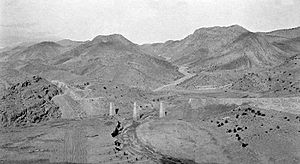Abo Canyon facts for kids
Quick facts for kids Abo Pass |
|
|---|---|
| Elevation | 5,771 ft (1,759 m) |
| Traversed by | BNSF Railway |
| Location | Socorro County, New Mexico, US |
| Range | Manzano Mountains |
Abo Canyon, also known as Abo Pass, is a mountain pass located at the southern end of the Manzano Mountains in central New Mexico. It sits at an elevation of 5,771 feet (about 1,759 meters) above sea level. This pass has been an important route for travel and trade for hundreds of years.
Contents
A Look Back: History of Abo Pass
From very old times, even before Christopher Columbus arrived in America, Abo Pass was a key trading route. Native American groups, like the Puebloan peoples from the Rio Grande valley to the west and the plains Indians from the Estancia Valley to the east, used this path to trade goods.
Their trading route went right past Abo Pueblo, which was a village built in the 1300s. This village was perfectly placed near natural springs on the eastern side of the pass. Today, you can still explore parts of this old route, which is now called the Abo Pass Trail Scenic Byway.
When the Spanish arrived in the 1500s, they also found the pass useful. They used it to travel between the Rio Grande valley and three special "salt missions" they built. These missions were churches and settlements, and their ruins are now part of the Salinas Pueblo Missions National Monument.
The Railroad Through Abo Canyon

In the early 1900s, the Atchison, Topeka and Santa Fe Railway wanted a better way to move trains across the country. Their old routes over Raton Pass and Glorieta Pass had very steep hills (called gradients), which made it hard for trains. They looked for a new path and found Abo Canyon.
The company built a new railway line through Abo Canyon, which had much gentler slopes. This new route, finished in 1908, was called the Belen Cutoff. It connected the railway system at Belen, New Mexico and Amarillo, Texas. Soon, most of the Santa Fe's long-distance freight trains started using this new, easier route.
Today, this railway corridor is part of the BNSF Railway system and is one of the busiest train routes in the western United States. In 2006, almost 90 trains passed through Abo Canyon every day! These trains were often very long, usually between 6,000 and 8,000 feet.
For a long time, the four-mile section through the canyon only had one track, which could cause delays. But in March 2011, a second track was finished. This cost $85 million and made train travel through the canyon much smoother and faster.
Driving Through Abo Pass
The Atlantic and Pacific Highway was created through Abo Pass in 1921. Later, in 1931, it became known as U.S. Route 60. If you're driving from Belen on the west side of the pass, New Mexico State Road 47 also connects to this highway.
The Abo Pass Trail Scenic Byway
On July 31, 1998, the Abo Pass Trail was officially named a New Mexico Scenic and Historic Byway. This means it's a special road known for its beautiful views and historical importance. It's a 31-mile drive that takes you through the historic Salt Missions area, following parts of New Mexico State Road 47 and U.S. Route 60.
See Also
- Scenic byways in the United States


